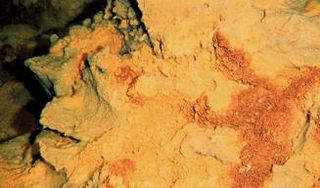Related Research Articles

In bacteriology, gram-positive bacteria are bacteria that give a positive result in the Gram stain test, which is traditionally used to quickly classify bacteria into two broad categories according to their type of cell wall.

The phylum "Bacteroidetes" is composed of three large classes of Gram-negative, nonsporeforming, anaerobic or aerobic, and rod-shaped bacteria that are widely distributed in the environment, including in soil, sediments, and sea water, as well as in the guts and on the skin of animals.

Acidobacteria is a phylum of bacteria. Its members are physiologically diverse and ubiquitous, especially in soils, but are under-represented in culture.
Fibrobacteres is a small bacterial phylum which includes many of the major rumen bacteria, allowing for the degradation of plant-based cellulose in ruminant animals. Members of this phylum were categorized in other phyla. The genus Fibrobacter was removed from the genus Bacteroides in 1988.

Gracilicutes is a clade in bacterial phylogeny.

16S ribosomal RNA is the RNA component of the 30S subunit of a prokaryotic ribosome. It binds to the Shine-Dalgarno sequence and provides most of the SSU structure.
The Chloroflexi or Chlorobacteria are a phylum of bacteria containing isolates with a diversity of phenotypes, including members that are aerobic thermophiles, which use oxygen and grow well in high temperatures; anoxygenic phototrophs, which use light for photosynthesis ; and anaerobic halorespirers, which uses halogenated organics as electron acceptors.

The FCB group is a superphylum of bacteria named after the main member phyla Fibrobacteres, Chlorobi, and Bacteroidetes. The members are considered to form a clade due to a number of conserved signature indels.

Bacterial phyla constitute the major lineages of the domain Bacteria. While the exact definition of a bacterial phylum is debated, a popular definition is that a bacterial phylum is a monophyletic lineage of bacteria whose 16S rRNA genes share a pairwise sequence identity of ~75% or less with those of the members of other bacterial phyla.
Saccharibacteria, formerly known as TM7, is a major bacterial lineage. It was discovered through 16S rRNA sequencing.

The class Zetaproteobacteria is the sixth and most recently described class of the Proteobacteria. Zetaproteobacteria can also refer to the group of organisms assigned to this class. The Zetaproteobacteria were originally represented by a single described species, Mariprofundus ferrooxydans, which is an iron-oxidizing neutrophilic chemolithoautotroph originally isolated from Loihi Seamount in 1996 (post-eruption). Molecular cloning techniques focusing on the small subunit ribosomal RNA gene have also been used to identify a more diverse majority of the Zetaproteobacteria that have as yet been unculturable.
Atribacteria is a candidate phylum of bacteria, which are common in anoxic sediments rich in methane. It was previously known as a candidate edge OP9 or JS1. They are distributed worldwide and in some cases abundant in anaerobic marine sediments, geothermal springs, and oil deposits. Genetic analyzes suggest a heterotrophic metabolism that gives rise to fermentation products such as acetate, ethanol, and CO2. These products in turn can support methanogens within the sediment microbial community and explain the frequent occurrence of Atribacteria in methane-rich anoxic sediments. According to phylogenetic analysis Atribacteria appears to be related to several thermophilic phyla within Terrabacteria or may be in the base of Gracilicutes. According to research, Atribacteria shows patterns of gene expressions which consists of fermentative, acetogenic metabolism. These expressions let Atribacteria to be able to create catabolic and anabolic functions which are necessary to generate cellular reproduction, even when the energy levels are limited due to the depletion of dissolved oxygen in the areas of sea waters, fresh waters, or ground waters.
The deep biosphere is the part of the biosphere that resides below the first few meters of the surface. It extends down at least 5 kilometers below the continental surface and 10.5 kilometers below the sea surface, at temperatures that may reach beyond 100°C. It includes all three domains of life and the genetic diversity rivals that on the surface.
Gracilibacteria is a bacterial candidate phylum formerly known as GN02, BD1-5, or SN-2. It is part of the Candidate Phyla Radiation and the Patescibacteria group.
Zixibacteria is a bacterial phylum with candidate status, meaning it had no cultured representatives. It is a member of the FCB group
Fermentibacteria is a bacterial phylum with candidate status. It is part of the FCB group.
Delphibacteria is a candidate bacterial phylum in the FCB group. The phylum was first proposed after analysis of two genomes from the mouths of two bottlenose dolphins. "Dephibacteria" was proposed in recognition of the first genomic representatives having been recovered from the dolphin mouth. Members of the Delphibacteria phylum have been retroactively detected in a variety of environments.
Modulibacteria is a bacterial phylum formerly known as KS3B3 or GN06. It is a candidate phylum, meaning there are no cultured representatives of this group. Members of the Modulibacteria phylum are known to cause fatal filament overgrowth (bulking) in high-rate industrial anaerobic wastewater treatment bioreactors.

NC10 is a bacterial phylum with candidate status, meaning its members remain uncultured to date. The difficulty in producing lab cultures may be linked to low growth rates and other limiting growth factors.
Cytophagales is an order of non-spore forming, rod-shaped, Gram-negative bacteria that move through a gliding or flexing motion. These chemoorganotrophs are important remineralizers of organic materials into micronutrients. They are widely dispersed in the environment, found in ecosystems including soil, freshwater, seawater and sea ice. Cytophagales is included in the Bacteroidetes phylum.
References
- ↑ Tarn, J., Peoples, L. M., Hardy, K., Cameron, J., & Bartlett, D. H. (2016). Identification of Free-Living and Particle-Associated Microbial Communities Present in Hadal Regions of the Mariana Trench. Frontiers in microbiology, 7.
- ↑ Hamilton, T. L., Bovee, R. J., Sattin, S. R., Mohr, W., Gilhooly III, W. P., Lyons, T. W., ... & Macalady, J. L. (2016). Carbon and sulfur cycling below the chemocline in a meromictic lake and the identification of a novel taxonomic lineage in the FCB superphylum, Candidatus Aegiribacteria. Frontiers in microbiology, 7.